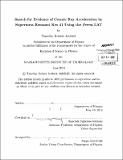Search for evidence of cosmic ray acceleration by supernova Remnant Kes 41 using the Fermi LAT
Author(s)
Joubert, Timothy Robert
DownloadFull printable version (4.969Mb)
Other Contributors
Massachusetts Institute of Technology. Department of Physics.
Advisor
Enectali Figueroa-Feliciano.
Terms of use
Metadata
Show full item recordAbstract
The analysis presented in this paper incorporated photon events received during the full run time of the Fermi Gamma Space Telescope (FGST) Large Area Telescope (LAT) to date. By studying the [gamma]y emission of the supernova remnant (SNR) Kes 41 for the energy range ~ 200MeV-200GeV, the [gamma]-ray morphology and spectrum were measured. These measurements required the use of reduced log likelihood statistics mediated by the Fermi Science Tools toolkit, developed for LAT analysis. The spatial analysis of the [gamma]-ray emission was measured at 5[sigma] for the area within and around the contours established during radio measurements [25]. It also resembles Kes 41's observed, centrally bright, X-ray emission [18, 25]. Spectral analysis was also carried out and the resulting [gamma]-ray spectrum was successfully fit to a power-law model of emission consistent with [pi]⁰-decay, a form of non-thermal emission caused by cosmic ray acceleration. An overall approximation of the [gamma]-ray luminosity was then measured as L[gamma] = 1.94 x 1035 erg/s using a measure of the total [gamma]-ray flux. A calculation also measured the particle density associated with material interacting with Kes 41 emission as n = 0.15 particles/cm-3. This value resembles that from other calculations involving SNR-Molecular cloud interaction [22]. This interaction serves to constrain [gamma]-ray emission to the [pi]⁰-decay channel, so evidence of a similar density value may be evidence that the significant [gamma]-ray emission observed, was due to the acceleration of cosmic rays.
Description
Thesis (S.B.)--Massachusetts Institute of Technology, Dept. of Physics, 2013. Cataloged from PDF version of thesis. Includes bibliographical references (pages 55-57).
Date issued
2013Department
Massachusetts Institute of Technology. Department of PhysicsPublisher
Massachusetts Institute of Technology
Keywords
Physics.